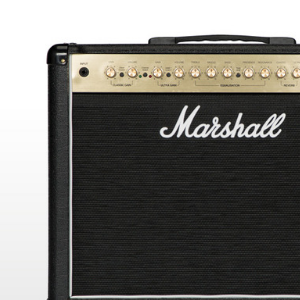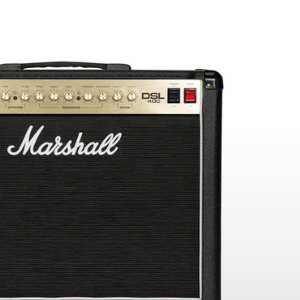- Home
- Instruments
- Gear
- Recording
- Lessons
- Reviews
- Blog


| Controls: |  |
| Features: |  |
| Performance: |  |
| Value: |  |
If you think about an amp, the first name that comes to mind is Marshall. Used by guitar legends past and present, Marshall amps are as synonymous with rock & roll history as Fender guitars. We are looking at the Marshall DSL40C (Dual Super Lead), 40 watts of real valve power packed in a classic Marshall design. With so many amps on the market, we want to find out if the DSL40C is the best amp you can buy under $1000.
 Features
FeaturesSimplicity is key with the DSL40C, as it always is with Marshall amps, but easy to use doesn't mean it lacks features.
It's a two-channel amp, classic gain, and ultra gain, with each channel having two unique modes. Essentially, what you have are four different voices to play with. Classic gain splits into clean and crunch, while the ultra gain channel splits into lead one and lead two. Each channel has its own digital reverb control.
The EQ section has the expected controls, but the addition of resonance control allows you to be extremely precise when dialing in your low end. Presence control lets you change the treble frequency, and a tone shift switch lets you change the voicing of the mid-range. All of this is on top of your basic EQ (bass, middle, treble) settings, of course.
The amp pushes the sound out of a 12″ Celestion 70/80 speaker, which is suitable for gigging/recording without being overpowering. A pentode/triode switch lets you go from 40w to 20w, making it great for practicing a little quieter without holding back your tone.

True to any Marshall amp, the front panel is clean and very user-friendly. Each channel has a gain control, volume control, and a mode select button. Between the two sets of channel controls, you'll find a simple channel selection button.
Moving onto the EQ section, the controls are still nice and clear. The first three knobs control your bass, middle, and treble levels like any basic EQ. The tone shift button is next, pressing that will give you extra-scooped mids. Rounding off the EQ section are the variable presence and resonance knobs; sometimes amps have a deep switch to add some kick to your bass, but a resonance knob gives you much more detailed control. The EQ section is what's known as a shared EQ, meaning the settings are applied to both channels.
This amp also comes with a footswitch, but it has somewhat limited use – it can switch channels or control reverb.
The reverb section is straight forward; you have a knob to set the amount for each channel. Lastly, the pentode/triode switch for changing between 40w and 20w finishes off the controls.
If we go through the channels/modes in order, the clean mode is impeccable with just enough room to bring in a little dirt. The crunch has a surprisingly wide range and easily captures that classic Marshall saturated crunch, made famous by so many rock legends. If that's all a little too safe for you, then switching to the ultra gain channel will have you shattering glass in no time.
The lead one mode is inspired by the iconic JCM800 and will take you back to the glory days of 80's metal. If you want to step it up another notch, lead two is even nastier. With more gain and a slight mid-boost, lead two is an animal that can be tamed by using the EQ section well.
The Marshall DSL40C is a fantastic amp; at under $1000, it's one of the best options out there. It sounds great clean or dirty, the EQ section can dial in some very precise tones, and it delivers a classic Marshall sound. If there are any complaints, it's that it's a little heavy, and the footswitch could be more functional, but who cares when you are rocking out?!
For more info about the Marshall DSL40C, click here.
For more guitar amps under $1000, click here.

Reader Interactions